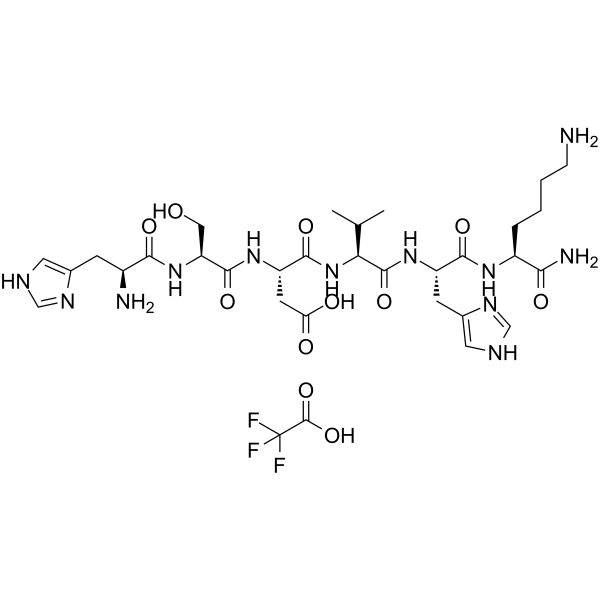上海金畔生物科技有限公司为生命科学和医药研发人员提供生物活性分子抑制剂、激动剂、特异性抑制剂、化合物库、重组蛋白,专注于信号通路和疾病研究领域。
HSDVHK-NH2 TFA
HSDVHK-NH2 TFA 是整合素 αvβ3-玻璃体结合蛋白的互作拮抗剂,其 IC50 值为 1.74 pg/mL (2.414 pM)。
HSDVHK-NH2 TFA Chemical Structure
| 规格 |
|
是否有货 |
|
| 100 mg |
|
询价 |
|
| 250 mg |
|
询价 |
|
| 500 mg |
|
询价 |
|
* Please select Quantity before adding items.
HSDVHK-NH2 TFA 的其他形式现货产品:
HSDVHK-NH2
| 生物活性 |
HSDVHK-NH2 TFA is an antagonist of the integrin αvβ3-vitronectin interaction, with an IC50 of 1.74 pg/mL (2.414 pM)[1][2].
|
体外研究
(In Vitro) |
HSDVHK significantly inhibited bFGF-induced cell migration compared to the PBS control group[1].
The Arg-Gly-Asp (RGD)-binding site recognition by HSDVHK-NH2 (P11) is site specific because the HSDVHK-NH2 (P11) is inactive for the complex formation of a denatured form of integrin–vitronectin. HSDVHK-NH2 (P11) shows a strong antagonism against avb3-GRGDSP interaction with an IC50 value of 25.72 nM[2].
HSDVHK-NH2 (P11) inhibits the HUVEC proliferation due to the induction of HUVEC cell death through caspases activations and its mechanism is related with increased p53 expression[3].
上海金畔生物科技有限公司 has not independently confirmed the accuracy of these methods. They are for reference only.
Cell Proliferation Assay[3]
| Cell Line: |
HUVEC cells. |
| Concentration: |
0.1, 1, 10, and 100 μg/mL. |
| Incubation Time: |
72 h. |
| Result: |
Significantly inhibited HUVEC proliferation on denatured collagen-coated plates in a dose-dependent manner. |
|
| 分子量 |
|
| Formula |
|
| Sequence Shortening |
|
| 运输条件 |
Room temperature in continental US; may vary elsewhere.
|
| 储存方式 |
Please store the product under the recommended conditions in the Certificate of Analysis.
|
| Solvent & Solubility |
In Vitro:
H2O
Peptide Solubility and Storage Guidelines:
1. Calculate the length of the peptide.
2. Calculate the overall charge of the entire peptide according to the following table:
| |
Contents |
Assign value |
| Acidic amino acid |
Asp (D), Glu (E), and the C-terminal -COOH. |
-1 |
| Basic amino acid |
Arg (R), Lys (K), His (H), and the N-terminal -NH2 |
+1 |
| Neutral amino acid |
Gly (G), Ala (A), Leu (L), Ile (I), Val (V), Cys (C), Met (M), Thr (T), Ser (S), Phe (F), Tyr (Y), Trp (W), Pro (P), Asn (N), Gln (Q) |
0 |
3. Recommended solution:
| Overall charge of peptide |
Details |
| Negative (<0) |
1. Try to dissolve the peptide in water first.
2. If water fails, add NH4OH (<50 μL).
3. If the peptide still does not dissolve, add DMSO (50-100 μL) to solubilize the peptide. |
| Positive (>0) |
1. Try to dissolve the peptide in water first.
2. If water fails, try dissolving the peptide in a 10%-30% acetic acid solution.
3. If the peptide still does not dissolve, try dissolving the peptide in a small amount of DMSO. |
| Zero (=0) |
1. Try to dissolve the peptide in organic solvent (acetonitrile, methanol, etc.) first.
2. For very hydrophobic peptides, try dissolving the peptide in a small amount of DMSO, and then dilute the solution with water to the desired concentration. |
|
| 参考文献 |
-
[1]. Yoonsuk Lee, et al. High-throughput screening of novel peptide inhibitors of an integrin receptor from the hexapeptide library by using a protein microarray chip. J Biomol Screen. 2004 Dec;9(8):687-94.
[2]. Youngjin Choi, et al. Site-specific inhibition of integrin alpha v beta 3-vitronectin association by a ser-asp-val sequence through an Arg-Gly-Asp-binding site of the integrin. Proteomics. 2010 Jan;10(1):72-80.
[3]. Ji-Young Bang, et al. Pharmacoproteomic analysis of a novel cell-permeable peptide inhibitor of tumor-induced angiogenesis. Mol Cell Proteomics. 2011 Aug;10(8):M110.005264.
|
所有产品仅用作科学研究或药证申报,我们不为任何个人用途提供产品和服务

